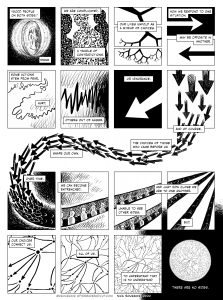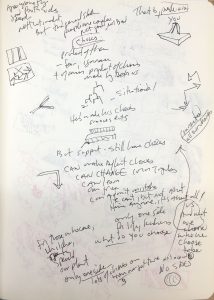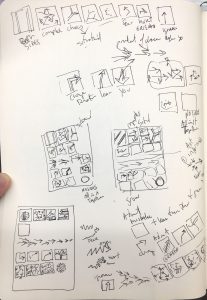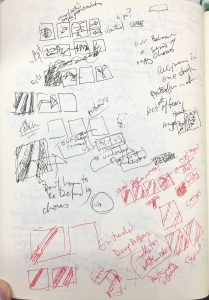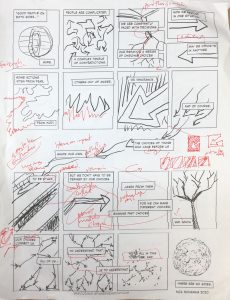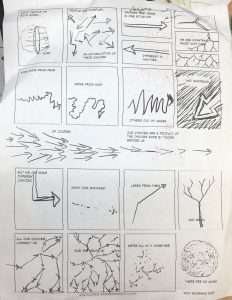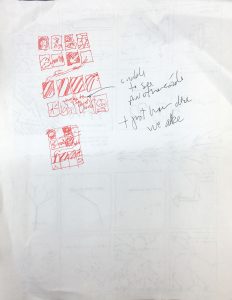A bunch of things about my teaching below, but first: I made a new short comic that has something to do with now and the last several years. It’s about wrestling with divisions and connections. The pared down approach came out of something I was trying with my students on zoom – exercises to get them thinking about different ways to work with lines, and their use of black and white on the page (as I’ll share more below). It doesn’t attempt to answer anything, but I hope in these uncertain times, it helps a few people pause and look differently at the world around them…
In this time when we have to reinvent our teaching (and our lives) remotely, I’ve tried to come up with ways to do the spontaneous and collaborative activities I do in my courses, via Zoom. The collaborative part has been trickier (though we’re getting there), but the solo efforts have been good. This particular exercise went with a discussion on inking and spot blacks – can see student examples on twitter here. In my last post, I shared my two chapters in the new book on teaching with comics With Great Power Comes Great Pedagogy. Well, a good chunk of that book has now been made freely available, including my chapter on the evolution of my teaching that breaks down many of the exercises I do with students. That’s all available here. As always, my class syllabi, exercises, student examples, and tons of other resources for teaching comics are all available here.
Try yourself! What would have been in-class, collab improv exercise instead Ss did @ home solo: 1pg 7-panel comic using 1 technique from list per panel: cross hatch; parallel lines; feathering; stipling; silhouette; No lines/negative space by black; shadow/spot black; wild card pic.twitter.com/v4r2Yq5CNc
— Nick Sousanis (@Nsousanis) April 14, 2020
Another example of it, a few weeks later, from a student I’ve had in a few classes, but came to my classes initially with no drawing experience. This is a huge achievement!
Wow! Absolutely brilliant comic by my student @carlos32176!! Took our improv inking exercise (1 panel crosshatching, 1 silhouette, feathering, etc…) and turned it into a really powerful piece on our current moment. So pleased! @SFSU @SFStateLCA https://t.co/IjVIocUWVt
— Nick Sousanis (@Nsousanis) April 20, 2020
Some other exercises you may wish to try. I do a project in my visual communication class based on my chapter in Unflattening the Shape of Our Thoughts. I laid it all out in a twitter thread here with student examples.
An invitation in 4 tweets! Before break, Ss shared their "Shape of Your Thoughts" projects – one of my favorite things! They make a piece & describe meaning in their choices (in class & writing). Post your own #shapeofthoughts (Past examples pictured, this year's next tweet) 1/4 pic.twitter.com/foU4Y1gQo0
— Nick Sousanis (@Nsousanis) March 25, 2020
Along those lines, I do a simple exercise based on the meandering lines in Tristram Shandy and Kurt Vonnegut’s brilliant talk detailing his diagrams of the shape of stories, where students talk about coming to university by drawing a single line and all the curves, angles, etc, it moves through before the current moment. See how to set it up along with student examples here. Data storyteller RJ Andrews did a virtual talk with my students this term – it was quite wonderful, and extremely important in helping us think about data in this moment when we are immersed in it as the world deals with a pandemic. We recorded it for class, and you can watch it here. Highly recommend checking it out!
An explanation for a "story line" activity I do in classes that others may wish to try – could see it adapted well to this moment. Based on Tristram Shandy squiggles & Vonnegut's Shape of Stories, explanation & examples in thread & my site #storyline 1/5https://t.co/2oIx7IMQJL pic.twitter.com/CkXwtBmobK
— Nick Sousanis (@Nsousanis) April 17, 2020
Beijing graduate design student Jessie Yu created an animation that plays off of themes in Unflattening and uses several pages from it throughout the animation. I thought it was pretty cool, and you can see it on YouTube here.
Finally, the kind folks at Harvard University Press made a page from Unflattening available for coloring – if you’re into such things, can download it here. In the meantime, I hope this finds you all safe and well.


